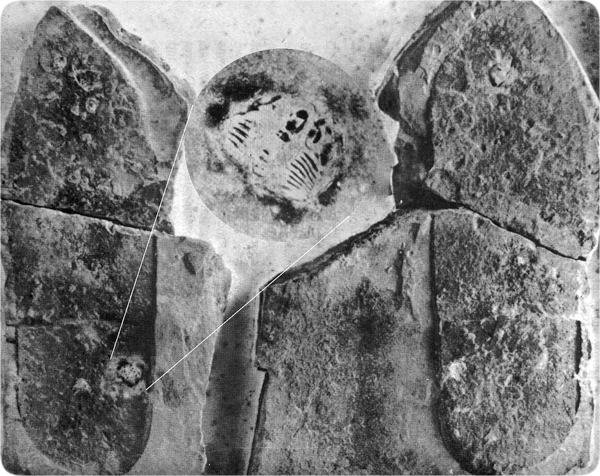Show your support by donating any amount. (Note: We are still technically a for-profit company, so your
contribution is not tax-deductible.)
PayPal Acct:  Feedback:
Feedback: 
Donate to VoyForums (PayPal):
| [ Login ] [ Contact Forum Admin ] [ Main index ] [ Post a new message ] [ Search | Check update time | Archives: 1, 2, 3, 4, 5, 6, 7, 8, 9, [10] ] |
Humanlike footprints, supposedly 150–600 million years old, have been found in rock formations in Utah (a), Kentucky (b), Missouri (c), and possibly Pennsylvania (d). At Laetoli, in the east African country of Tanzania, a team headed by Mary Leakey found a sequence of humanlike footprints (e). They were dated at 3.7 million years. If human feet made any of these prints, then evolutionary chronology is drastically wrong.

Figure 30: Humanlike Footprints with Trilobite. In 1968, 43 miles northwest of Delta, Utah, William J. Meister found apparent human shoe prints inside a 2-inch-thick slab of rock. Also in that slab were obvious trilobite fossils, one of which was squashed under the “heel.” According to evolutionists, trilobites became extinct 240 million years before humans evolved. Others have since made similar discoveries at this location, although this is the only fossil where a trilobite was inside an apparent shoe print.
a. Melvin A. Cook, “William J. Meister Discovery of Human Footprints with Trilobites in a Cambrian Formation of Western Utah,” Why Not Creation? editor Walter E. Lammerts (Phillipsburg, New Jersey: Presbyterian and Reformed Publishing Co., 1970), pp. 185–19.
Michael A. Cremo and Richard L. Thompson, Forbidden Archeology (San Diego: Bhaktivedanta Institute, 1993), pp. 810–813.
b. “Geology and Ethnology Disagree about Rock Prints,” Science News Letter, 10 December 1938, p. 372.
c. Henry R. Schoolcraft and Thomas H. Benton, “Remarks on the Prints of Human Feet, Observed in the Secondary Limestone of the Mississippi Valley,” The American Journal of Science and Arts, Vol. 5, 1822, pp. 223–231.
d. “Human-Like Tracks in Stone are Riddle to Scientists,” Science News Letter, 29 October 1938, pp. 278–279.
e. “‘Make no mistake about it,’ says Tim [White, who is probably recognized as the leading authority on the Laetoli footprints]. ‘They are like modern human footprints. If one were left in the sand of a California beach today, and a four-year-old were asked what it was, he would instantly say that someone had walked there. He wouldn’t be able to tell it from a hundred other prints on the beach, nor would you. The external morphology is the same. There is a well-shaped modern heel with a strong arch and a good ball of the foot in front of it. The big toe is straight in line. It doesn’t stick out to the side like an ape toe, or like the big toe in so many drawings you see of Australopithecines in books.’” Johanson and Edey, p. 250.
The big toe of Australopithecus africanus splayed out to the side, as in apes. Obviously, the Laetoli footprints were not made by Australopithecines, as most evolutionists claim.
“In sum, the 3.5-million-year-old footprint trails at Laetoli Site G resemble those of habitually unshod modern humans. None of their features suggest that the Laetoli hominids were less capable bipeds than we are. If the G footprints were not known to be so old, we would readily conclude that they were made by a member of our genus, Homo. ...we should shelve the loose assumption that the Laetoli footprints were made by Lucy’s kind, Australopithecus afarensis.” Russell H. Tuttle, “The Pitted Pattern of Laetoli Feet,” Natural History, Vol. 99, March 1990, p. 64.
Techniques That Argue for an Old Earth Are Either Illogical or Are Based on Unreasonable Assumptions.
To estimate a date prior to the beginning of written records, one must assume that the dating clock has operated at a known rate, that the clock’s initial setting is known, and that the clock has not been disturbed. These three assumptions are almost always unstated, overlooked, or invalid.
[From “In the Beginning” by Walt Brown
http://www.creationscience.com/onlinebook/AstroPhysicalSciences28.html]
[
Next Thread |
Previous Thread |
Next Message |
Previous Message
]
|
Forum timezone: GMT-8 VF Version: 3.00b, ConfDB: Before posting please read our privacy policy. VoyForums(tm) is a Free Service from Voyager Info-Systems. Copyright © 1998-2019 Voyager Info-Systems. All Rights Reserved. |